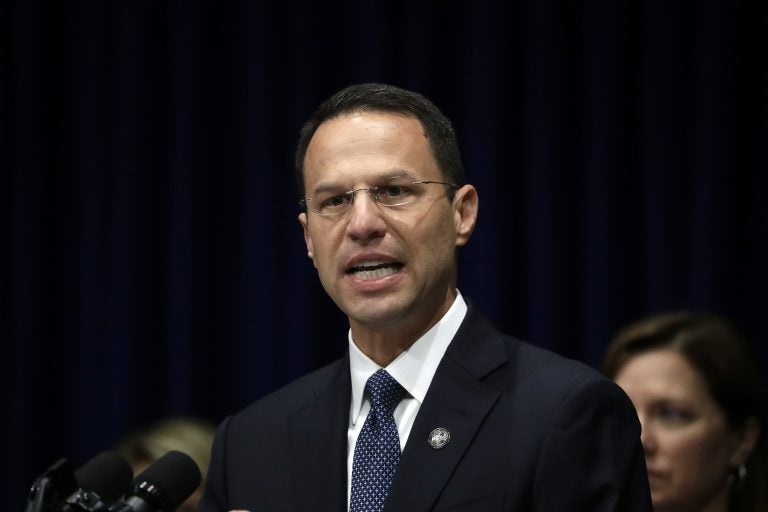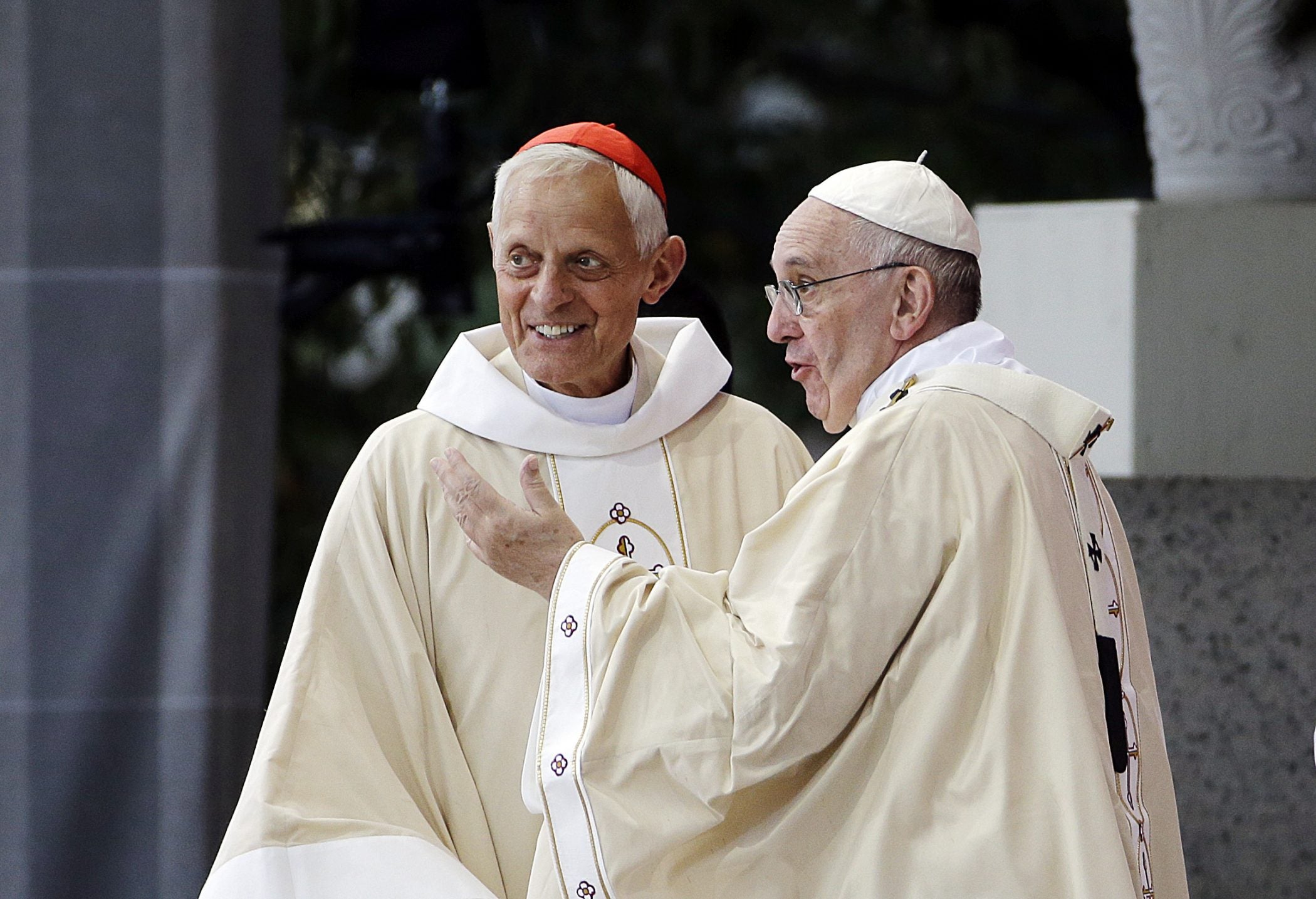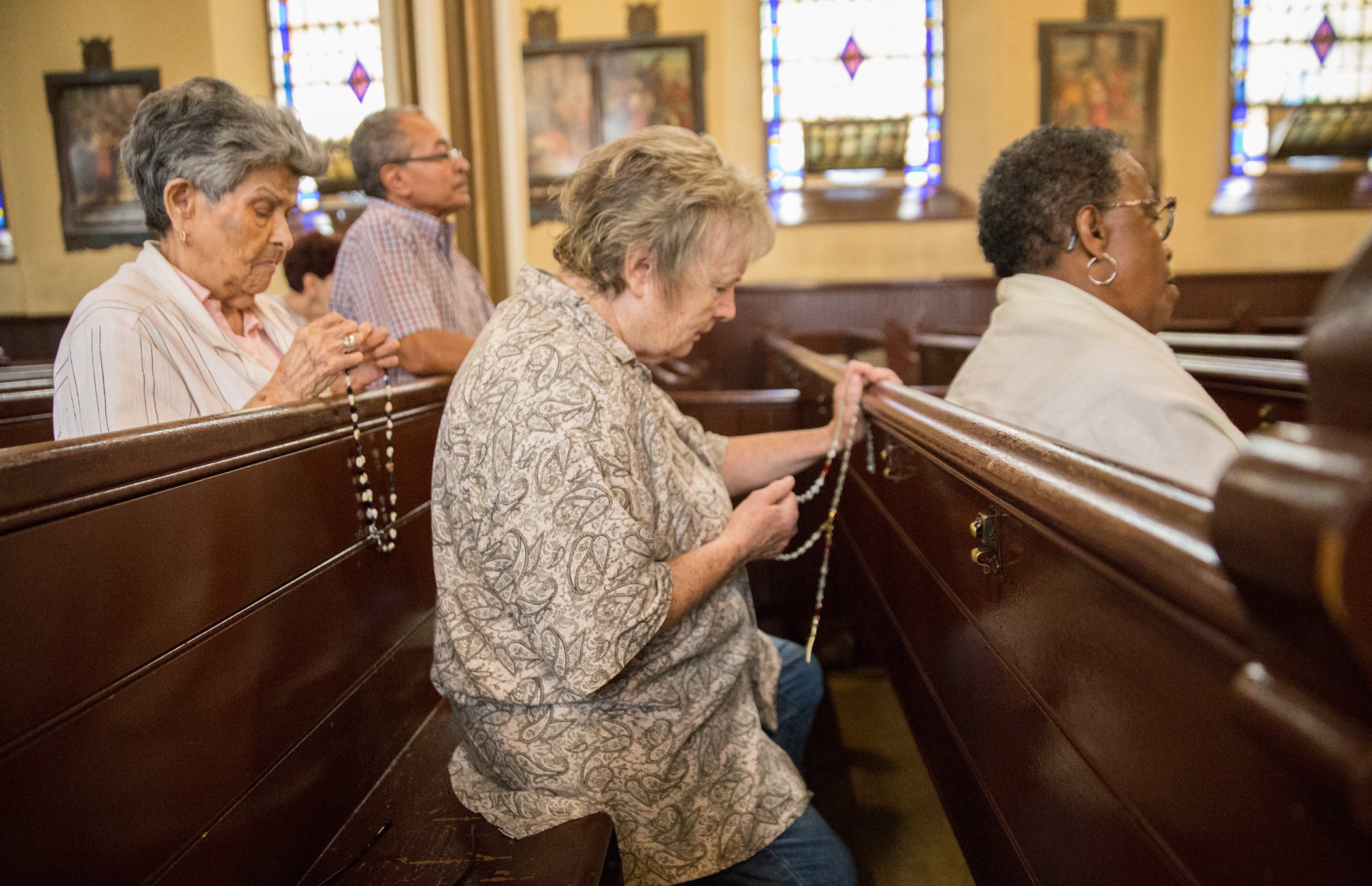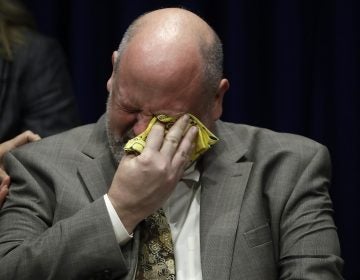Report details 1,000 victims of child sexual abuse by 300 ‘predator priests’ across Pa.
The roughly 900 page report, paints a horrid portrait of activity that occurred in the dioceses of Scranton, Allentown, Harrisburg, Greensburg, Erie and Pittsburgh.
Listen 11:55
Pennsylvania Attorney General Josh Shapiro says more charges await following an investigation into decades of cases of the Catholic clergy sexually abusing children. (AP Photo/Matt Rourke)
Updated: 5:52 p.m.
A long-awaited grand jury investigation into clergy sexual abuse in Pennsylvania was released Tuesday in an interim, redacted form — detailing decades of alleged misconduct and cover-ups in six of the state’s eight Roman Catholic dioceses.
The roughly 900-page report, thought to be the most comprehensive of its kind, paints a horrid portrait of activity that occurred in the dioceses of Scranton, Allentown, Harrisburg, Greensburg, Erie and Pittsburgh, implicating 300 “predator priests” statewide who committed “criminal and/or morally reprehensible conduct.”
The grand jury found credible allegations by more than one thousand victims, but added “we believe that the real number … is in the thousands.”
The full report can be found at the bottom of this page.
One priest in the Diocese of Harrisburg — against whom previous reports were never acted on — abused five sisters in a single family. Another, in the Diocese of Greensburg, impregnated a 17-year-old girl, married her, then divorced her months later.
A priest in the Diocese of Erie admitted to assaulting at least a dozen boys, yet the bishop later thanked him for “all that you have done for God’s people.”
In another instance from the Pittsburgh Diocese, a boy was forced to stand on a bed in a rectory, strip naked, and pose as Christ on the cross for at least 4 priests. They then took photos of the boy and added them to a collection of child pornography which they shared on church grounds.
The grand jury said it reviewed half a million pages of internal church documents and “secret archives” that were readily available to bishops. The findings revealed a pattern of abuse that occurred in hundreds of parishes in 54 of Pennsylvania’s 67 counties going back at least 80 years. It detailed how fellow clergy members conducted shoddy investigations into sexual abuse allegations and how bishops often sided with abusive priests.
“The pattern was abuse, deny, and cover-up,” said Attorney General Josh Shapiro at a press conference in Harrisburg Tuesday, who described a “systematic cover-up” and a “failure of law enforcement.”
The report counted 41 “predator priests” in the Diocese of Erie, 37 in Allentown, 20 in Greensburg, 45 in Harrisburg, 99 in Pittsburgh, and 59 in Scranton.
The interim report was released just before the 2 p.m. deadline the Pa. Supreme Court gave its appointed special master to sort out disputes regarding the redactions.
“We, the members of this grand jury, need you to hear this. We know some of you have heard some of it before. There have been other reports about child sex abuse within the Catholic Church. But never on this scale. For many of us, those earlier stories happened someplace else, someplace away. Now we know the truth: it happened everywhere.”
— The 40th Statewide Investigating Grand Jury.
A majority of the activity described within the scathing investigation falls outside of Pennsylvania’s statute of limitations for sexual crimes, and those clergy members both named and currently blacked out of the report are not expected to face criminal charges.
But the grand jury issued presentments against a priest in the Greensburg Diocese and a priest in the Erie Diocese, who it said had sexually assaulted children within the last decade.
“Despite some institutional reform, individual leaders of the church have largely escaped public accountability. Priests were raping little boys and girls, and the men of God who were responsible for them not only did nothing; they hid it all. For decades. Monsignors, auxiliary bishops, bishops, archbishops, cardinals have mostly been protected; many, including some named in this report, have been promoted. Until that changes, we think it is too early to close the book on the Catholic Church sex scandal.”
— The 40th Statewide Investigating Grand Jury.
In the wake of Shapiro’s press conference, several of the dioceses released statements.
“Sadly, abuse still is part of the society in which we live. We acknowledge our past failures, and we are determined to do what is necessary to protect the innocent, now and in the future,” wrote Allentown Diocese bishop Alfred A. Schlert.
Named prominently in the report is Cardinal Donald Wuerl, the archbishop of Washington, D.C., who served as the bishop of Pittsburgh from 1988 through 2006.
The grand jury found that Wuerl allegedly shuffled around abusive priests and failed to inform church officials in other states of priests who were moved there after facing sexual abuse allegations in the Pittsburgh Diocese.
In a letter to priests late Monday, Wuerl said he acted to protect children after learning about allegations of sexual abuse.
“It moved me not simply to address these acts, but to be fully engaged, to meet with survivors and their families, and to do what I could to bring them comfort and try to begin a process for healing,” Wuerl wrote, claiming he imposed a “zero tolerance” policy for clergy sex abuse.

When Wuerl came to Pittsburgh, he replaced then-Bishop Anthony Bevilacqua, who went on to become Archbishop of Philadelphia, where a grand jury found he had protected abusive priests. Bevilacqua died in 2012.
Bishop Edward C. Malesic, of the Diocese of Greensburg, reacted to the report in a homily that will be played in parishes across the diocese this weekend.
“Those priests acted as wolves among us even if they were dressed in sheep’s clothing. I am sorry for that,” Malesic said. “In fact, honestly, I am extremely angry at them for what they did to you.”
In the Erie Diocese, where the grand jury identified 41 “predator priests,” Bishop Lawrence Persico apologized to the victims of child sexual abuse and said the diocese would work to bring them justice.
“Today, I pledge the following to victims: the Diocese of Erie will not shroud abusers in secrecy no matter who they are or how long ago the abuse has occurred.”
Attorney General Shapiro claimed the Erie Diocese and Persico’s predecessor, Bishop Emeritus Donald Trautman, knew about allegations and even admissions of child sex abuse committed by priests for years, but covered them up and allowed abusers to remain in active ministry.
Although the Archdiocese of Philadelphia wasn’t a focus of this report, Archbishop Charles Chaput emphasized that reforms have been made since a city grand jury made similar revelations in 2005.
“The work undertaken in Philadelphia over the past 15 years has resulted in dramatically safer environments for all those in our care,” said Chaput in a statement. “I want to reaffirm as forcefully as I can that we have a zero tolerance policy for clergy, lay employees, or volunteers who engage in the abuse of children or other misconduct with minors. We take immediate action when an allegation of misconduct is made.”
What’s next?
The grand jury made a list of recommendations, including eliminating the statute of limitations for child sexual abuse. It also called for a “civil window” law, which would give victims a two-year period to file civil charges retroactively.
“We saw these victims; they are marked for life. Many of them wind up addicted, or impaired, or dead before their time,” wrote the grand jury.
Currently in Pennsylvania, victims of child sex abuse who turned 18 after Aug. 27, 2002, have until age 50 to file criminal charges. Those who turned 18 before that date cannot bring a criminal case.
For civil charges, child victims have until their 30th birthday to file, no matter when the abuse occurred.
Facing stiff opposition from groups such as the Pennsylvania Catholic Conference, legislation advancing such measures hasn’t found consensus.
The grand jury also called on Pennsylvania lawmakers to tighten the requirements on clergy members to report alleged sexual abuse to the police and eliminate the use of confidentiality agreements in cases where an abusive priest could face criminal charges.
Following the release of the grand jury report, the Pennsylvania Office of Victim Advocate, the Pennsylvania Coalition Against Rape, and the Archdiocese of Philadelphia’s Office for Child and Youth Protection joined to share resources and provide support services to survivors.
“This report and its scope may deeply impact victims and our community at large,” the groups said, in a joint statement. “We want all affected to know they are not alone — there are free and confidential resources for those victims identified within the report, for parishioners in need of assistance with processing the report, as well as the community in general who may need guidance in talking through the emotional toll.”
Parishioner reaction

For Catholics who felt that the church received an unfair amount of scrutiny, the report provided some closure after a necessary but painful investigation into decades of abuse across Pennsylvania parishes.
Pat Kastelnik led a group of parishioners in praying the Rosary at the Holy Infancy Roman Catholic in Bethlehem, Pennsylvania in the hours before the grand jury report was released.
“Right now we need to pray for all of those priests — some of them are falsely accused — some of them are rightly accused — and one of the big problems has been the cover up by Bishops,” Kastelnik said after mass Tuesday afternoon. “This needs to end and we need to pray for all of them.”
Kastelnik added that no abuse is permissible, but “at this point in time they are shining a light at the Catholic Church and it seems like it is out of proportion.”
Mary Anne Chickey also attended a daily mass in Bethlehem, Pa.
“This is one of the biggest things that stops people from becoming Catholics,” said Chickey, after mass at Holy Infancy Roman Catholic in Bethlehem, Pennsylvania. “Every religion has something. But boy, oh boy this is a biggie.”
Long legal battle
The 40th Statewide Investigating Grand Jury was convened in 2016 in an investigation led by the Pa. attorney general. Tuesday’s redacted report came after months of legal battles challenging its release.
It was initially slated for public view at the end of June, but was delayed after a group of unnamed current and former clergy filed objections claiming that publishing the report would violate their due process rights.
Attorneys for the clergy said the state should not be able to name or implicate individuals without charging them with a crime or allowing them to challenge evidence and cross-examine witnesses. As is typical in grand jury proceedings, the clergy members had been invited to file a written response to the report.
In response to objections from about two dozen current and former clergy, the state Supreme Court stayed the report’s release to allow more time for appeals.
Nine news outlets — including WHYY, the lead station of Keystone Crossroads — and the state attorney general’s office then pushed to make the report public, even if only in a redacted form.
Attorney General Josh Shapiro called the clergy’s appeals a “desperate attempt to stop the public from learning the truth about their abhorrent conduct,” and said he opposes giving clergy the option to essentially rewrite the report “in accordance with their preferred view of the facts.”
Norman Krumenacker III, the Cambria County judge who presided over the grand jury investigation, also disagreed with the clergy and pushed for an unredacted report to be released in full.
The Pa. Supreme Court said Krumenacker’s logic was flawed. It argued that the Pa. Constitution compels the court to put a high premium on an individual’s right to reputation. In a July 27 order, the high court agreed with an alternate plan proposed by the media intervenors and decided a version which redacted the names of the objectors would be released by mid-August.
The high court chose Judge John M. Cleland of McKean County as the special master to work out any disputes over how to black out the report.
Cleland, 70, had been drawn out of retirement in 2011 to preside over Jerry Sandusky’s trial. He was also chairman of the state commission impaneled to investigate the “kids-for-cash” corruption scandal that plagued Luzerne County’s juvenile court in 2008.
Hearings to decide if the complaints by individual clergy members are valid will be held in September in Philadelphia.
The group of unnamed challengers said even a redacted version would violate grand jury secrecy rules, because it includes specific facts from the report and “would impermissibly lift the cloak of anonymity they have been afforded.”
The legal battle has sparked a debate over Pennsylvania’s use of grand jury proceedings, in which 23 jurors meet in private to sort through potential evidence on complicated crimes or issues of public importance.
Prosecutors say such proceedings can help develop particularly difficult cases and bring to light issues that would otherwise remain hidden. Critics say the process should not be used to identify and criticize individuals who haven’t been charged with crimes.
Abuse in the Philadelphia and Altoona-Johnstown dioceses have been covered in previous reports.
—
Read the full report:
WHYY is your source for fact-based, in-depth journalism and information. As a nonprofit organization, we rely on financial support from readers like you. Please give today.






